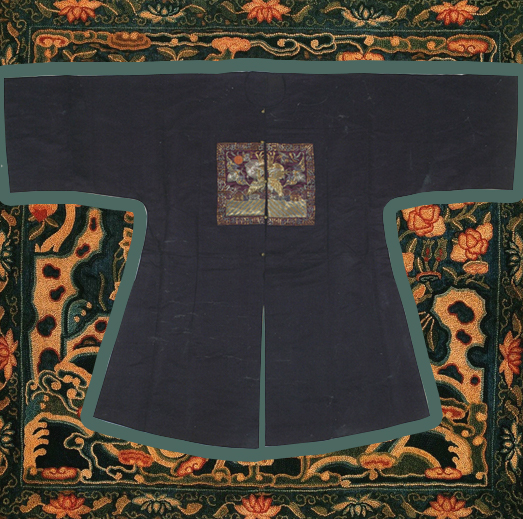I thought I would pay tribute to my stay in Hong Kong this winter and write an Asia-themed dress history blog post about Chinese rank badges.
The Chinese rank badges, also referred to as mandarin squares, are silk badges that were once embroidered or woven onto the front and back of court robes, as an indication of a wearer’s rank within the Chinese court and were worn primarily between 1391 and 1911, during the Ming and Qing dynasties.
The origin of the rank badges can be traced to square embroidered plaques containing animal and flower designs featured on the robes of Yuan dynasty (1260-1368) officials, mostly for decorative purposes. These badges were not designated as official court dress until the Ming dynasty (1368-1644). The mandarin badges, indicating a court official’s rank, were to be sewn onto the front and back of their court robes. It was determined that there would be nine ranks for both the literary and military officials; different animals were designated for different ranks. Birds were associated with literary elegance and were to be used for the civil officials, whereas carnivorous mammals were associated with courage and fierceness of soldiers, to be used for the military officials. This system survived the collapse of the Ming dynasty and the succeeding Qing dynasty (1644-1911) retained the same rank badge system.

The Ming and Qing rank badges differed stylistically and structurally, although the animal and bird iconography remained consistent. The Ming badges had a few identifying visual and physical characteristics that differed from the Qing squares. The most obvious features were the size and shape. Most Ming badges were at least 35 cm in dimension and lacked any distinct borders. The Ming badges were sewn from seam end to seam end across the front of the robes, and were slightly trapezoidal in shape, as the Ming robes were wider near the bottom. Furthermore, strict Ming sumptuary laws forbade Ming officials from using too much gold, which resulted in most emblems embroidered in satin stitch or laid floss-silk. Only the principal design was outlined in heavier gold threads.

Compared to the Ming squares, the Qing badges were a lot smaller, ranging on average from 25 to 30 cm in size. Moreover, the addition of the ornamental border and the unique innovation of the ‘sun disk’ to symbolize the emperor became the standard trends of the Qing dynasty rank badges. However, the most distinctive feature was the split seam down the center of the Qing square, which most Ming squares lacked. The split in the badge was a result of the structure of the bu fu, the surcoat on which the mandarin squares were attached. The bu fu, a creation of the Qing dynasty, opened down the front, which meant that the mandarin square on the front side was made in halves, one on each side of the coat flaps; the mandarin square on the backside was made in one piece. Contrastingly, the Ming squares, both the front and back badges, were made in whole, undisturbed by the flaps, since the Ming robes were designed to open to the side.
Besides the obvious structural difference between the Ming and Qing dynasty squares, there are also various stylistic, and thematic differences in each era. To find out more about the stylistic, and technical developments of Chinese rank badges, I recommend reading works by Schuyler V. Cammann, who has written most prolifically on mandarin squares.
By Lily Mu
References:
Wang, Zhihou. The Splendors of Costume: Special Exhibition Attire from Ming and Qing Dynasties. China: Qi Lu Press, 2013.
Haig, Paul; Shelton, Marla. Threads of Gold: Chinese Textiles, Ming to Ch’ing. Pennsylvania: Schiffer Publishing, 2006.


